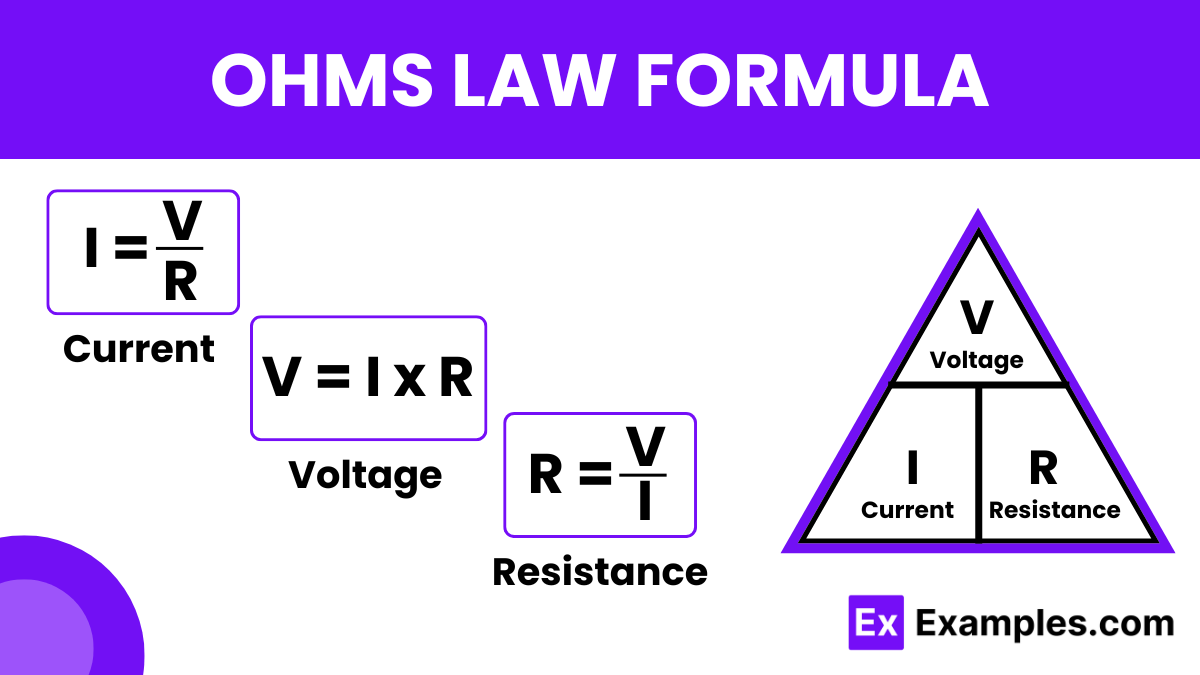What is the formula for Ohm\'s Law?
V = IR
V = I/R
V = I + R
V = I − R


Ohm’s Law, a crucial concept in electrical physics, was discovered by Georg Simon Ohm, a German physicist, in 1827. This law provides a simple formula to understand the relationship between voltage, current, and resistance in an electrical circuit. The formula is expressed as:
The formula indicates that the current (𝐼) flowing through a conductor is directly proportional to the voltage (𝑉) applied across its ends and inversely proportional to the resistance (𝑅) of the conductor. This means that if you increase the voltage, the current will increase if the resistance remains constant. Similarly, if you increase the resistance, the current will decrease for a constant voltage.
To derive Ohm’s Law, consider a circuit where a voltage V is applied across a resistor R. The current 𝐼 that flows due to this voltage can be calculated by rearranging the formula to solve for I, leading to 𝐼 = 𝑉 / 𝑅. This straightforward formula helps in designing and analyzing circuits by allowing calculations of how changes in voltage and resistance affect the current.
This formula helps to determine the voltage required across a component to produce a certain current flow, given the component’s resistance. It is particularly useful in power supply design, where maintaining specific voltage levels is crucial for device functionality. For instance, if you wish a current of 3 amperes to flow through a resistor of 4 ohms, the required voltage across the resistor would be 𝑉=3×4=12 volts.
This formula is used to find the resistance of a component when the voltage across it and the current flowing through it are known. This formula is essential when designing circuits with specific resistance values to control current flow. For example, if a voltage of 20 volts results in a current of 4 amperes, the resistance of the circuit must be 𝑅=20 / 4=5 ohms.
Given: A 12-volt battery is connected across a resistor with a resistance of 6 ohms.
Question: What is the current flowing through the resistor?
Solution: Using Ohm’s Law 𝐼 = 𝑉 / R,
𝐼=12/6 = 2 amperes
Thus, the current flowing through the resistor is 2 amperes.
Given: A current of 5 amperes flows through a circuit that includes a single resistor of 10 ohms.
Question: What is the voltage across the resistor?
Solution: Applying Ohm’s Law 𝑉 = 𝐼 x 𝑅, 𝑉=5×10=50 volts
Therefore, the voltage across the resistor is 50 volts.
Given: A circuit component has a current of 3 amperes flowing through it when a voltage of 15 volts is applied across it.
Question: What is the resistance of the component?
Solution: Using the formula 𝑅 = 𝑉 / 𝐼, 𝑅=153=5 ohms
Hence, the resistance of the component is 5 ohms.
Ohm’s Law applies to ohmic materials with constant resistance, not to non-ohmic materials like diodes.
Ohm’s Law only applies to linear, ohmic components and fails with components that change resistance.
Doubling the voltage while keeping resistance constant doubles the current, as per Ohm’s Law.
Text prompt
Add Tone
10 Examples of Public speaking
20 Examples of Gas lighting
What is the formula for Ohm\'s Law?
V = IR
V = I/R
V = I + R
V = I − R
If the voltage is 12 V and the resistance is 4 Ω, what is the current?
3 A
4 A
12 A
48 A
A circuit has a current of 2 A and a resistance of 5 Ω. What is the voltage?
5 V
7 V
10 V
15 V
What is the resistance in a circuit with a voltage of 24 V and a current of 6 A?
2 Ω
4 Ω
8 Ω
10 Ω
If the resistance in a circuit is doubled while the voltage remains the same, what happens to the current?
It doubles
It halves
It remains the same
It quadruples
A light bulb operates with a current of 0.5 A and a voltage of 120 V. What is the resistance of the bulb?
60 Ω
120 Ω
240 Ω
180 Ω
A resistor has a resistance of 10 Ω and the current through it is 2 A. What is the voltage across the resistor?
10 V
15 V
20 V
30 V
A device has a resistance of 8 Ω and the current flowing through it is 1.5 A. What is the voltage?
8 V
10 V
12 V
15 V
What is the current through a 100 Ω resistor connected to a 200 V power supply?
1 A
2 A
3 A
4 A
If the resistance in a circuit is 25 Ω and the current is 4 A, what is the voltage?
50 V
100 V
150 V
200 V
Before you leave, take our quick quiz to enhance your learning!

